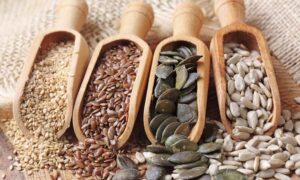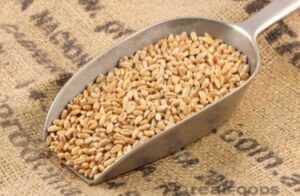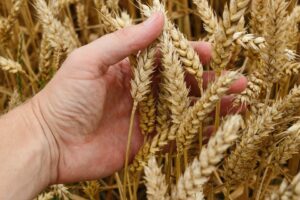
Ukraine will be able to export 50 million tons of grains and oilseeds from the 2023 harvest, as well as about 10 million tons of vegetable oils and meals to global markets, said Mykola Gorbachev, president of the Ukrainian Grain Association.
“We planned to export about 5 million tons per month. However, in the first four months (the grain marketing year starts in July – IF-U) this did not happen. We were unable to increase shipments through the Danube ports, which accounted for 3.5-3.7 million tons per month. With the launch of the grain corridor, the ports of Greater Odesa have a lot of potential. It is possible to ship 3-4 million tons (of grains and oilseeds – IF-U) per month through the ports of Greater Odesa alone,” he said at the Business Breakfast with Forbes Ukraine on Wednesday.
In total, Ukraine will be able to export about 6 million tons of grain a month through the sea corridor and across its western borders, according to the UGA president’s estimates, which was already done in November.
“We will be able to work harder, increase (exports – IF-U) a little bit more, and I think it will be technically feasible to supply 50 million tons of grains and oilseeds to foreign markets,” Gorbachev said.
He added that Ukraine will produce another 10 million tons of agro-processed products, including vegetable oils and meals.
“We will sell most of the grain and manufactured products. For us, this is more than 50% of the country’s foreign exchange earnings, which stabilizes the hryvnia. I think the state has little choice: either the harvest will rot or it is better to sell it. Of course, it’s better to sell,” said the UGA president and expressed confidence that traders will cope with this task if the military ensures the safety of shipping at the current level.
Gorbachev emphasized that in 2023 Ukraine managed to maintain its status as the world’s breadbasket, as farmers grew 81 million tons of grains and oilseeds against domestic consumption of 23-24 million tons. He emphasized that Ukraine produces three to four times more crops and processed products than it consumes, so the agricultural sector is clearly export-oriented.

PrJSC United Mining and Chemical Company (UMCC), which manages Vilnohirsk Mining and Metallurgical Plant (VGMK, Dnipro region) and Irshansk Mining and Processing Plant (IGOK, Zhytomyr region), has discussed with potential customers the supply of over 200 thousand tons of titanium ore next year.
According to the company’s press release, the discussion of possible supplies took place at the 17th annual TZMI Congress, the largest exhibition of the global titanium industry, which took place in Singapore.
Thanks to the event, which brought together the largest players in the titanium market, UMCC representatives held a number of meetings to expand international cooperation and plan supplies for 2024. In particular, preliminary negotiations were held with leading companies from America, Japan, the UK and the European Union.
“The total volume of supplies discussed for the next year is more than 200 thousand tons of UMCC products. We have now started working on the next stages of negotiations with counterparties and procedures preceding the signing of contracts. We hope that the expansion of cooperation, which we are now actively working on, will help increase the economic stability of the company,” said Dimitri Kalandadze, Deputy Chairman of the Board of the company, as quoted by the press service.
At the same time, he stated that the blockade of export routes and shelling of maritime infrastructure by Russia lead to disruptions in the delivery of products to customers. This directly affects the image of Ukrainian exporters and delays payment for goods. However, in such circumstances, it is very important to develop alternative ways of cooperation and expand it. This is a priority for the company’s management, summarized the Deputy Chairman of the Board.
The United Mining and Chemical Company started its actual operations in August 2014, when the Ukrainian government decided to transfer the property complexes of Vilnohirsk Mining and Metallurgical Plant (VGMK, Dnipropetrovska oblast) and Irshansk Mining and Processing Plant (IGOK, Zhytomyrska oblast) to its management. Previously, these plants were leased to Firtash’s structures. Then the company was transformed into a PJSC and then into a PrJSC.
In August 2016, the government included UMCC in the list of companies to be privatized in 2017. Its deadline was postponed several times, and the tender was disrupted twice.
UMCC used to sell its products to more than 30 countries and was one of the world’s largest producers of titanium raw materials, accounting for 4% of the global market. The company mines titanium ore.

If the sea corridor is fully operational, more than 50% of export shipments in 2024 will be carried by sea, said Yuriy Vaskov, Deputy Minister of Communities, Territories and Infrastructure Development, at Infrastructure Day 2023 organized by the European Business Association in Kyiv on Friday.
“We expect that in 2024, more than 50% of export transportation will be carried out by sea. As was the case with the Grain Initiative when it was in operation, 52% (of shipments) were through the ports of Greater Odesa, and the remaining 48% were through the Danube and Western borders. This will be the case for all industries,” the Deputy Minister said.
According to him, the functioning of the corridor and the Danube ports will help accelerate GDP growth.
“The functioning of the Ukrainian maritime corridor in 2024 will give at least 8% to Ukraine’s GDP growth. If we have +5% in our budget, then if the sea corridor and the Danube are operational, we will have +13% growth. That is why it is important,” Vaskov said.
The deputy minister noted that Ukraine is interested in expanding shipping channels, including by restoring them in the Mykolaiv region. However, the decision will be made depending on the security situation.
“As for the expansion. Of course, we are interested in this. Of course, we will do everything to restore shipping in the Mykolaiv region as soon as possible, but it will depend on the military situation. As long as we have the occupied Kinburn Spit, unfortunately, it is dangerous,” the Deputy Minister said.
Earlier it was reported that 151 vessels have used the Ukrainian sea corridor established by the Ukrainian Navy since August 10, 2023, 121 of which have already used it with 4.4 million tons of export cargo.

Based on the results of the analysis of export operations with agricultural products, BES analysts found that over 9 months, risky enterprises exported grain of unknown origin for UAH 133.9 billion. This is more than 20% of the total amount.
Currently, the Bureau of Economic Security has submitted its proposals to the Cabinet of Ministers of Ukraine to minimize risks in this sector of the economy.
One of the most common methods of “black” grain exports is the use of risky enterprises. They are set up in advance to export unaccounted-for grain purchased for cash.
In other words, farmers grow grain and sell it for cash to companies that are usually registered to front companies and do not engage in regular business activities.
These companies do not submit documents on the origin of the grain or declare fictitious producers in their customs declarations.
After the grain leaves Ukraine, it is resold several times and then legally reaches the final buyer. As a result, foreign currency earnings do not return to Ukraine, and the budget does not receive any revenues, as the exporting companies are fictitious.
Usually, the final buyer of grain is a non-resident company that transfers the money for the goods to another non-resident company related to a Ukrainian exporter.
There is also a scheme in which foreign currency is transferred to the current accounts of a non-resident, who then buys the goods, for example, in China and imports them to Ukraine to sell them for cash and to give other companies a tax credit.
To counteract offenses in this area, employees of the Economic Security Bureau constantly analyze export operations. Based on the results of such analysis, 43 analytical products and certificates were created, and almost 4,500 orders to initiate inspection (re-inspection) of goods were sent to the State Customs Service. For example, according to the BES in Odesa region, the customs office refused to clear 75 customs declarations totaling 1.6 million tons worth more than $430 million.
As part of 22 criminal proceedings, BES detectives served notices of suspicion to 12 officials of “risky” grain exporters for committing crimes under Articles 212 and 205-1 of the Criminal Code of Ukraine, conducted 71 searches, and sent 12 criminal proceedings to court. The courts have issued 8 indictments.

Since the beginning of the Russian aggression, Ukraine has been forced to change the geography of agricultural exports, as a result of which the share of Europe reached 59% in January-October 2023 compared to 32% in 2021, the Ukrainian Agribusiness Club (UCAB) reported on Facebook.
According to the report, such an increase in exports of agricultural products to Europe is forced and is explained by a decrease in supplies to other regions: the share of Africa decreased to 7% from 14%, Asia – to 12% from 19%, and Southeast Asia – to 4% from 13%.
“The main reason for these changes is the blockade of Ukrainian seaports by Russian troops. The development of alternative routes, which were possible only through the territory of the EU countries, led to changes. Ukrainian farmers were forced to look for buyers of their products in Europe,” the analysts explained.
The UCAB reminded that deliveries to Africa and Asia during the war became possible only thanks to the work of the grain corridor in cooperation with the UN and Turkey, as well as the temporary grain corridor, which is currently shipping.
In 2023, the structure of exports of Ukrainian agricultural products in terms of the main export items is similar to last year’s figures: 39% were grains, 26% were vegetable oils, 4% were meat, and 2% were dairy products, eggs, and honey. At the same time, exports of oilseeds decreased to 12% compared to 16% in 2022, while exports of oilcake increased to 6% from 5% during the year. The permission to supply sugar to foreign markets allowed producers to increase its share in agricultural exports to 3% over the year.
In pre-war 2021, the structure of Ukraine’s agricultural exports was as follows: cereals – 45%, vegetable oils – 26%, oilseeds – 9%, meals – 6%, meat – 3%, and tobacco products – 2%.
“The only way to resume exports to Ukraine’s traditional markets is to ensure the safety of sea export routes and increase the volume of shipments through this channel,” the UCAB summarized.

In the 2022-2023 marketing year (MY), Ukrprominvest-Agro Group exported more than 120 thousand tons of sugar to the European Union, the group’s press service reported on Facebook.
“The quality of our products, excellent transaction support services, speed in decision-making, a variety of options for packaging and shipment of products, a responsible approach to work at every stage are the factors that have become the key to the success of Ukrprominvest-Agro in the export market in 2022/23 marketing year. We plan to further develop this area and maintain our leadership among sugar exporters in Ukraine in the current marketing year,” the press service quoted Artem Semenenko, Director of the company’s Commercial Department, as saying.
“Ukrprominvest-Agro is engaged in the cultivation of crops, production of sugar, flour, meat and dairy farming. The group’s land bank exceeds 116.5 thousand hectares and is located mainly in regions that have not been invaded by the Russian occupiers.
The total number of cattle of the agricultural holding is 6.3 thousand, pigs – 12 thousand. The total elevator storage capacity of the group is 120 thousand tons. The group’s sugar business is represented by two sugar factories in Vinnytsia region. It supplies grain processing products to Moldova, Georgia, Turkmenistan, Israel, Palestine, Angola, Lebanon, Syria, and Vietnam.
Ukrprominvest-Agro comprises Agroprodinvest Group LLC, PJSC Podillya Production Complex, LLC Zorya Podillya Production Complex, LLC Vinnytsia Bakery No. 2, AF Dniproagrolan, AF Ivankivtsi, LLC Mas-Agro, LLC Pravoberezhne, and LLC Progress-NT.
The owner of the agricultural holding since December 2019 is the son of the former President of Ukraine Oleksiy Poroshenko.